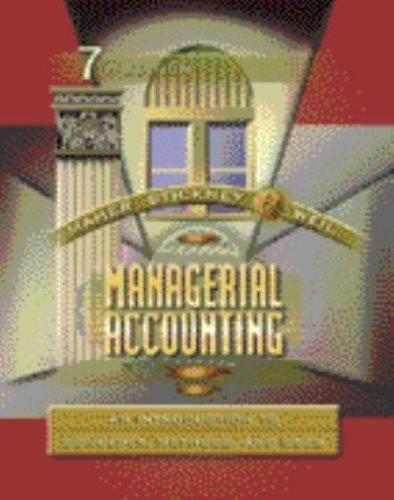The Foundational 15 (Algo) [LO11-2, LO11-3, LO11-4, LO11-5, LO11-6) [The following information applies to the questions displayed below) Cane Company manufactures two products called Alpha and Beta that sell for $135 and $95, respectively. Each product uses only one type of raw material that costs $6 per pound. The company has the capacity to annually produce 105,000 units of each product. Its average cost per unit for each product at this level of activity are given below: Direct materials Direct labor Variable manufacturing overhead Traceable fixed manufacturing overhead Variable selling expenses Common fixed expenses Total cost per unit Alpha $ 30 23 10 19 15 18 $ 115 Beta $ 18 16 8 21 11 13 $ 87 The company considers its traceable fixed manufacturing overhead to be avoidable, whereas its common fixed expenses are unavoidable and have been allocated to products based on sales dollars. Foundational 11-2 (Algo) 2. What is the company's total amount of common fixed expenses? Total common fixed expenses 5. Assume that Cane expects to produce and sell 98,000 Alphas during the current year. One of Cane's sales representatives has found a new customer who is willing to buy 13,000 additional Alphas for a price of $92 per unit; however pursuing this opportunity w decrease Alpha sales to regular customers by 6,000 units. a. What is the financial advantage (disadvantage) of accepting the new customer's order? b. Based on your calculations above should the special order be accepted? Complete this question by entering your answers in the tabs below. Reg SA Reg 58 What is the financial advantage (disadvantage) of accepting the new customer's order? Cane Company manufactures two products called Alpha and Beta that sell for $135 and $95, respectively. Each product uses only one type of raw material that costs $6 per pound. The company has the capacity to annually produce 105,000 units of each product. Its average cost per unit for each product at this level of activity are given below: Alpha Beta Direct materials $ 30 $ 18 Direct labor 23 16 Variable manufacturing overhead 10 8 Traceable fixed manufacturing overhead 19 21 Variable selling expenses 15 11 Common fixed expenses 18 13 Total cost per unit $ 115 $ 87 The company considers its traceable fixed manufacturing overhead to be avoidable, whereas its common fixed expenses are unavoidable and have been allocated to products based on sales dollars. Foundational 11-10 (Algo) 10. Assume that Cane expects to produce and sell 53,000 Alphas during the current year. A supplier has offered to manufacture and deliver 53,000 Alphas to Cane for a price of $92 per unit What is the financial advantage (disadvantage) of buying 53,000 units from the supplier instead of making those units? Cane Company manufactures two products called Alpha and Beta that sell for $135 and $95, respectively. Each product uses only one type of raw material that costs $6 per pound. The company has the capacity to annually produce 105,000 units of each product. Its average cost per unit for each product at this level of activity are given below. Direct materials Direct labor Variable manufacturing overhead Traceable fixed manufacturing overhead Variable selling expenses Common fixed expenses Total cost per unit Alpha $ 30 23 10 19 15 18 $ 115 Beta $. 18 16 8 21 11 13 $ 87 The company considers its traceable fixed manufacturing overhead to be avoidable, whereas its common fixed expenses are unavoidable and have been allocated to products based on sales dollars. Foundational 11-15 (Algo) 15. Assume that Cane's customers would buy a maximum of 83,000 units of Alpha and 63,000 units of Beta. Also assume that the company's raw material available for production is limited to 200,000 pounds. If Cane uses its 200,000 pounds of raw materials, up to how much should it be willing to pay per pound for additional raw materials? (Round your answer to 2 decimal places.) Maximum price to be paid per pound










